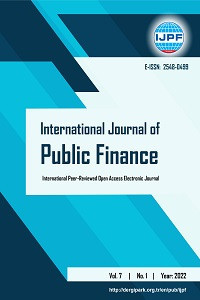Unionization and Labor Share of Income Distribution: An Empirical Investigation of OECD Countries
This paper investigates the effects of unionization of the labor force and capital openness on the labor share of the income distribution. This paper empirically studies the relationship between labor share and unionization for OECD countries by regressing labor share on unionization of the labor force and other controlling variables. We use the Generalized Least Squares estimation method in panel data for the period of 1999-2011. Our controlling variables include political stability, economic growth, and capital share. We employ different panel data techniques with different hypothesis testing for robustness. Our regression results show that an increase in capital openness decreases labor share while an increase in unionization rate increases it. On the other hand, political stability has a positive effect on labor shares while economic growth seems to affect labor shares negatively. Also, an increase in capital share decreases the labor share but it is not statistically significant.
Anahtar Kelimeler:
Unionization, Labor Share, Openness, Income Distribution
Unionization and Labor Share of Income Distribution: An Empirical Investigation of OECD Countries
This paper investigates the effects of unionization of the labor force and capital openness on the labor share of the income distribution. This paper empirically studies the relationship between labor share and unionization for OECD countries by regressing labor share on unionization of the labor force and other controlling variables. We use the Generalized Least Squares estimation method in panel data for the period of 1999-2011. Our controlling variables include political stability, economic growth, and capital share. We employ different panel data techniques with different hypothesis testing for robustness. Our regression results show that an increase in capital openness decreases labor share while an increase in unionization rate increases it. On the other hand, political stability has a positive effect on labor shares while economic growth seems to affect labor shares negatively. Also, an increase in capital share decreases the labor share but it is not statistically significant.
Keywords:
Unionization, Labor Share, Openness, Income Distribution,
___
- ReferencesChinn, M. D. & Ito, H. (2006). "What Matters for Financial Development? Capital Controls, Institutions, and Interactions." Journal of Development Economics, Vol. 81(1), pp. 163-192.
- Chinn, M. D. & Ito, H. (2016). “The Chinn-Ito Index”. (08.04.2016). http://web.pdx.edu/~ito/Chinn-Ito_website.htm.
- Elveren, A. Y., Marr, C., & Renard, Y. (2017). “Feminization of Labour and Profit Rates: Evidence from OECD Countries.” Applied Economics Letters, Vol. 24(7), pp. 481-484. doi: 10.1080/13504851.2016.1203057.
- Feenstra, R. C., Inklaar, R. & Timmer, M. P. (2015). "The Next Generation of the Penn World Table." American Economic Review, Vol. 105(10), pp. 3150-3182, available for download at www.ggdc.net/pwt .
- Fichtenbaum, R. (2009). “The Impact of Unions on Labor's Share of Income: A Time-Series Analysis.” Review of Political Economy, Vol. 21(4), pp. 567-588, doi: 10.1080/09538250903214859.
- Herzer, D. (2014). “Unions and Income Inequality: Evidence from Ireland”, Applied Economics Letters 21(1): 24-27. doi: 10.1080/13504851.2013.835471.
- Jayadev, A. (2007). “Capital Account Openness and the Labour Share of Income.” Cambridge Journal of Economics, Vol.31(3), pp. 423-443. doi: 10.1093/cje/bel037.
- Mishel, L. & Schieder, J. (2016). “As union membership has fallen, the top 10 percent have been getting a larger share of income.” Economic Policy Institute. https://www.epi.org/publication/as-union-membership-has-fallen-the-top-10-percent-have-been-getting-a-larger-share-of-income/.
- OECD & Visser, J. (2016). “ICTWSS database (Institutional Characteristics of Trade Unions, Wage Setting, State Intervention and Social Pacts)”. (08.04.2016). https://stats.oecd.org/Index.aspx?DataSetCode=UN_DEN.
- Penn World Table 8.1 (08.04.2016). doi: 10.15141/S5NP4S. https://www.rug.nl/ggdc/productivity/pwt/pwt-releases/pwt8.1.
- Schultz, T. P. & Mwabu, G. (1998). “Labor Unions and the Distribution of Wages and Employment in South Africa.” ILR Review, Vol. 51(4), pp. 680-703. doi: 10.1177/001979399805100407.
- The World Bank. “World Development Indicators”. (08.04.2016). http://databank.worldbank.org/data/reports.aspx?source=world-development-indicators.
- The World Bank. “Worldwide Governance Indicators”. (08.04.2016). http://databank.worldbank.org/data/source/worldwide-governance-indicators.
- Visser, J. (2016). “ICTWSS Database. version 5.1”. Amsterdam: Amsterdam Institute for Advanced Labour Studies (AIAS), University of Amsterdam. September 2016. http://www.uva-aias.net/en/ictwss/.
- Wallace, M., Leicht, K. T. & Raffalovich, L.E. (1999). “Unions, Strikes, and Labor’s Share of Income: A Quarterly Analysis of the United States, 1949-1992.” Social Science Research, Vol. 28(1999), pp. 265-288. doi: 10.1006/ssre.1999.0647.
- Young, A. T. & Lawson, R. A. (2014). “Capitalism and Labor Shares: A Cross-Country Panel Study.” European Journal of Political Economy, Vol. 33(2014), pp. 20-36. doi: 10.1016/j.ejpoleco.2013.11.006.
- Young, A. T. & Zuleta, H. (2018). “Do Unions Increase Labor Shares?: Evidence from US Industry-Level Data.” Eastern Economic Journal, Vol. 44(4), pp. 558-575. doi: 10.1057/s41302-016-0086-6.
- Yayın Aralığı: Yılda 2 Sayı
- Başlangıç: 2016
- Yayıncı: Adnan GERÇEK
Sayıdaki Diğer Makaleler
VAT Liabilities of Electronic Service Providers in Turkey
Erdem ATEŞAĞAOĞLU, Süheyl KARAKAYA
Unionization and Labor Share of Income Distribution: An Empirical Investigation of OECD Countries
Sacit Hadi AKDEDE, Sidre G.b. GÖCEKLİ
Impact of Fiscal Decentralization on Local Autonomy in the Sudan: Experience of Gadarif State
Tax System and Rates in the Republic Of Kosovo and Their Comparison with the Balkan Countries
OECD Ülkelerinde Genişletici Maliye Politikalarının Ekonomik Büyüme Üzerine Etkisi
Paul ONYANGO-DELEWA, İsaac NABETA NKOTE
